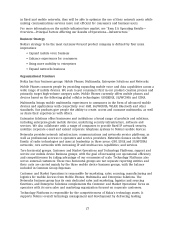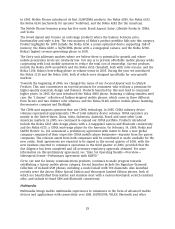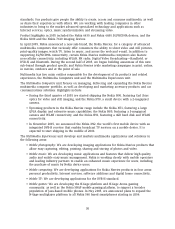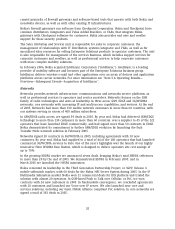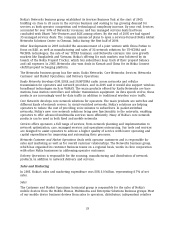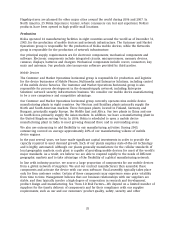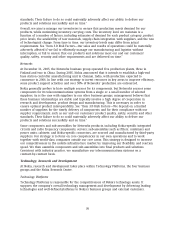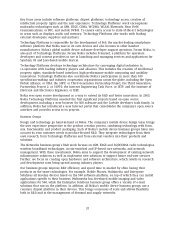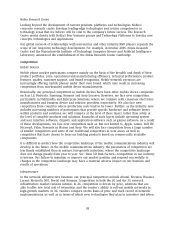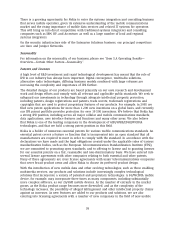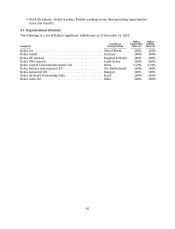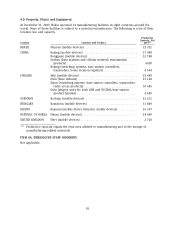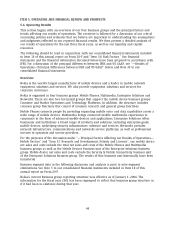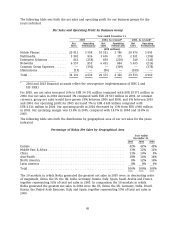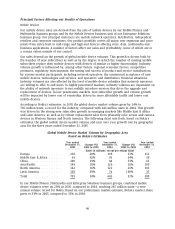Nokia 2005 Annual Report Download - page 38
Download and view the complete annual report
Please find page 38 of the 2005 Nokia annual report below. You can navigate through the pages in the report by either clicking on the pages listed below, or by using the keyword search tool below to find specific information within the annual report.standards. Their failure to do so could materially adversely affect our ability to deliver our
products and solutions successfully and on time.’’
Overall, we aim to manage our inventories to ensure that production meets demand for our
products, while minimizing inventory-carrying costs. The inventory level we maintain is a
function of a number of factors, including estimates of demand for each product category, product
price levels, the availability of raw materials, supply-chain integration with suppliers, and the rate
of technological change. From time to time, our inventory levels may differ from actual
requirements. See ‘‘Item 3.D Risk Factors—Our sales and results of operations could be materially
adversely affected if we fail to efficiently manage our manufacturing and logistics without
interruption, or fail to ensure that our products and solutions meet our and our customers’
quality, safety, security and other requirements and are delivered on time.’’
Networks
At December 31, 2005, the Networks business group operated five production plants, three in
Finland and two in China. During 2005, Nokia announced that it intends to establish a high-end
base station controller manufacturing unit in Chennai, India, with production expected to
commence in 2006. In line with our strategy to invest resources in key areas to improve efficiency,
some product support activities and over 50% of Networks’ production are outsourced.
Nokia generally prefers to have multiple sources for its components, but Networks sources some
components for its telecommunications systems from a single or a small number of selected
suppliers. As is the case with suppliers to our other business groups, management believes that
these business relationships are stable and typically involve a high degree of cooperation in
research and development, product design and manufacturing. This is necessary in order to
ensure optimal product interoperability. See ‘‘Item 3.D Risk Factors—We depend on a limited
number of suppliers for the timely delivery of components and for their compliance with our
supplier requirements, such as our and our customers’ product quality, safety, security and other
standards. Their failure to do so could materially adversely affect our ability to deliver our
products and solutions successfully and on time.’’
Some components and sub-assemblies for Networks products, including Nokia-specific integrated
circuits and radio frequency components; servers; sub-assemblies such as filters, combiners and
power units; cabinets; and Nokia-specific connectors, are sourced and manufactured by third-party
suppliers. Our strategy is to focus on core competencies in our own operations and to work
together with world-class companies outside our core areas. This strategy is designed to increase
our competitiveness in the mobile infrastructure market by improving our flexibility and reaction
speed. We then assemble components and sub-assemblies into final products and solutions.
Consistent with industry practice, we manufacture our telecommunications systems on a
contract-by-contract basis.
Technology, Research and Development
At Nokia, research and development takes place within Technology Platforms, the four business
groups and the Nokia Research Center.
Technology Platforms
Technology Platforms is responsible for the competitiveness of Nokia’s technology assets. It
supports the company’s overall technology management and development by delivering leading
technologies and well-defined platforms to Nokia’s business groups and external customers.
36



